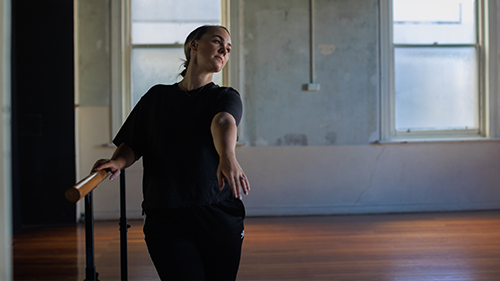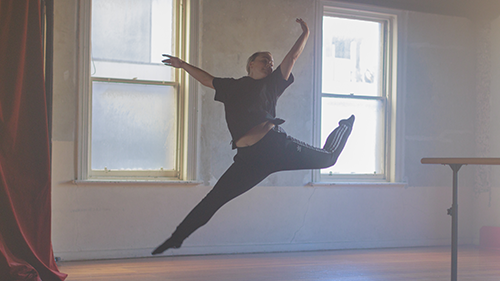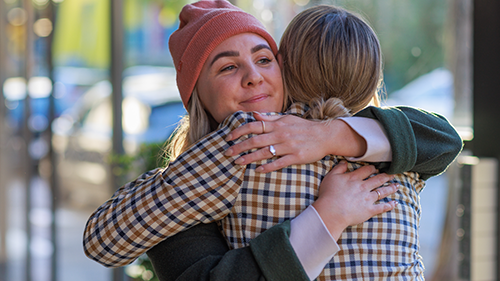Trauma and losing my coping strategy – Nicole’s story
After suffering an injury while dancing, Nicole struggled to deal with the impact of losing her greatest outlet.
For Nicole, dancing was both her happy place and her coping mechanism.
When she danced, she felt free yet completely in control.
When she danced, Nicole could escape her mental health issues.
When she ruptured her hamstring, Nicole’s dreams of dancing professionally were over and her coping mechanism was gone.
Without it, Nicole’s mental health began to spiral.
Childhood trauma, a lasting effect
As a child, Nicole was loud and bubbly. Her dad described her as ‘a little ray of sunshine’. But when she was 14, Nicole experienced something that impacted her heavily.
“I was put into a position where a very familiar and comforting environment was no longer safe. It was something I had to endure alone for some time,” she says.
“I internalised so much of the trauma that there was no way for those around me to really understand why I was moody or feeling anxious.”
“I started to exhibit OCD tendencies, because I really needed a way to control my environment. This included pulling my hair out. I was diagnosed with trichotillomania, which is a compulsive disorder. Similar to someone biting their nails, my brain was basically hardwired to do this repetitive habit to make me feel like I had control.”
As a result, Nicole had bald patches on her head and wore a headband to school to hide the damage. Nicole can still recall the moment she was presented on stage at her end-of-Year 12 assembly when the principal tried to remove her headband because it wasn’t part of school uniform.
“Even though I don’t think anyone else would have picked up on it at the time, it was a pretty traumatic experience for me.”
After high school, Nicole took off overseas, working at a summer holiday camp in America. It was the circuit breaker she needed before pursuing her goal of studying dancing.
Following her passion for dance
“I always wanted to grow up to become a dancer.”
At first, dancing was simply something that Nicole loved, something she dreamed of doing for the rest of her life. But after what she went through, dancing became more than just her passion.
It became an outlet, a sanctuary. A means of coping with her trauma. She still loved it, but it felt different. There was a reliance she hadn’t felt before.
It didn’t change her path. She powered on towards her goal, graduating from a prestigious dance academy in Melbourne.
A career-ending injury
In the lead up to her injury, Nicole was dancing eight hours a day, five days a week, as well as teaching classes. She kicked her leg out while demonstrating in front of a class and straight away knew something was wrong.
“I called my boyfriend to come grab me and by the time he got there, I was in tears standing in front my car, because I couldn’t even sit down,” says Nicole.
“We went to the hospital and they had to cut my pants off me to do an x-ray. Two days later, I was in emergency surgery because I’d done such a good job of ripping my hamstring off the bone.”
Nicole’s recovery was tough. There was the physical aspect of spending two months in a leg brace and undergoing multiple surgeries. Then there was the obvious impact the injury would have on her career and her dreams.
The impact on her mental health
After rehabbing her hamstring for nearly a year, Nicole tried to get back into dancing. It became clear she wouldn’t be able to.
“I loved dancing. It was this one outlet that allowed me to digest my emotions and I had to give it up,” says Nicole.
“I never really understood how much it was helping me mentally, because I could just exhaust all of my feelings into my dance. I could take everything that was frustrating me or making me sad and just put it into dance.”
Nicole had lost her dream job and her coping mechanism. Her mental health started to deteriorate.
She lost routine. Nicole pushed her partner and those closest to her away, began to withdraw socially, and would get anxious and irritable easily. Before long, it became clear she needed help.
Diagnosis, a sense of relief
Nicole’s turning point came when her boyfriend casually mentioned she might need to speak to someone.
“It was terrifying. I remember going to a GP and explaining that I just wasn’t okay.”
Her biggest learning from the session was how the GP spoke about Nicole’s experience.
“They didn’t ask why I felt that way, they just said they understood and gave me some options to explore,” says Nicole.
“I think that was the switch, that it wasn’t something to be judged, it was something to figure out how to be managed.”
Nicole was diagnosed with anxiety, depression and post-traumatic stress disorder. Being able to put a name to what she was going through allowed Nicole to speak honestly to those closest to her.
Opening up, managing her emotions
Nicole had hidden the trauma she had experienced as a teenager for years, even from some of her best friends. After her diagnoses, she felt comfortable talking to them about it.
“I realised that those closest to me would be able to understand me and support me better if I explained what had happened to me.”
Nicole still has her bad days but she’s no longer reliant on one single coping mechanism like she was with dancing. She spreads the load by exercising, volunteering and reaching out to close friends when she needs support.
Nicole accepts herself, including all of the experiences, good and bad, that made her the person she is today.
“I'm OK that people know certain things about me, like that I still have bald spots.”
“I’m not ashamed anymore. These experiences have ultimately made me the strong and resilient person I am today.”
Trichotillomania is a condition that compels people to pull out their hair. It is a psychiatric disorder that usually starts in childhood or adolescence. Trichotillomania can last for several months or many years, and may be worse at some times than others.
Photography by Good Grief Productions










